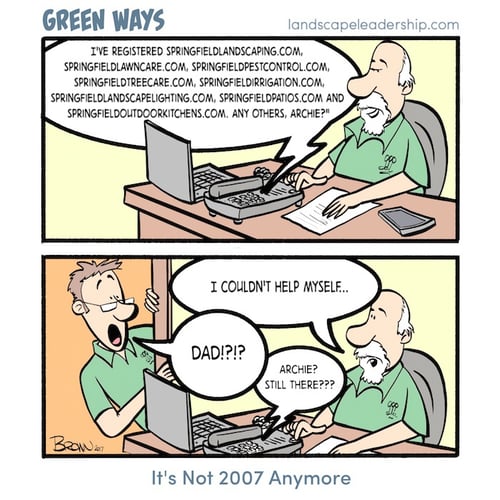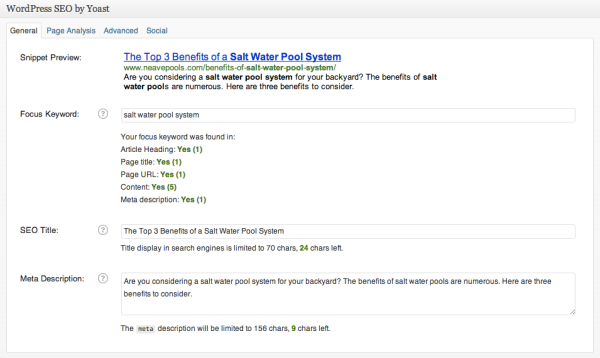Topics: Search Engine Optimization (Seo) Web Development
5 Critical SEO Mistakes to Avoid on Your Website
 Author: Chris Heiler
Author: Chris Heiler
 This will be the first in a two-part series outlining the most common mistakes we see green industry companies make related to search engine optimization (SEO) and their websites. In this first post we'll cover the on-page SEO mistakes companies make and then cover the off-page mistakes in our next post.
This will be the first in a two-part series outlining the most common mistakes we see green industry companies make related to search engine optimization (SEO) and their websites. In this first post we'll cover the on-page SEO mistakes companies make and then cover the off-page mistakes in our next post.
If you need to catch up on some SEO basics, especially related to on-page versus off-page ranking factors, give this post a read.
You have complete control over the on-page elements on your website so any mistakes you've made on your site should be fairly painless to clean up. Fixing what has been done off site is much more difficult because much is out of your control. Because of this, let's start with the on-page elements.
Keep in mind, your website needs to be designed up front with SEO being a top priority, but you have to balance that with creating a site that is truly user friendly. This can be a difficult balance to strike and where many mistakes are made. With that said, let's tackle the five most common SEO mistakes we see on green industry websites and offer a more effective solution for each.
On-Page SEO Mistake #1: Keyword stuffing
 Keyword stuffing is an old-school SEO tactic that will not help you one bit. Today search engines like Google better understand the context and relevancy of a web page and site. While keyword density may have been a strong signal in the past it no longer carries much weight compared to other signals and ranking factors like quality of inbound links and social shares.
Keyword stuffing is an old-school SEO tactic that will not help you one bit. Today search engines like Google better understand the context and relevancy of a web page and site. While keyword density may have been a strong signal in the past it no longer carries much weight compared to other signals and ranking factors like quality of inbound links and social shares.
That said, you still want to use best practices to optimize your pages for a primary keyword phrase, but you don't need to worry about using the keyword phrase an unnatural number of times throughout your content. The more natural your content reads, the better. Google is not going to serve up your web page in their search results if it is unreadable by humans (10 years ago, yes, but not today).
On-Page SEO Mistake #2: Not properly optimizing images
 Did you realize you can optimize your images for the search engines just like you would a blog post or web page? It's true, yet often overlooked.
Did you realize you can optimize your images for the search engines just like you would a blog post or web page? It's true, yet often overlooked.
What we've noticed is that many companies will pass on photos to an outside "webmaster" who will upload them to the website without considering how to optimize them. This is a huge mistake. You either need to provide your webmaster with the necessary information for each image so he/she can optimize them or you need to be uploading and optimizing the images yourself.
Take the necessary time to optimize your images for your important keywords and local search terms. Here are the simple steps involved:
- Rename the image file to include your keywords before you upload the image to your website. Ex: outdoor-kitchen-design-construction-stamford-connecticut.jpg
- Use these same keywords in the image title and image alt tags.
- Work these same keywords into the photo’s caption and description.
If you use a CMS like Wordpress or HubSpot this is extremely easy to do. The screenshot to the right shows an example from Wordpress’ editor tool.
On-Page SEO Mistake #3: Not properly optimizing meta data
Each page or blog post on your website has what is called meta data that essentially tells search engines what a particular page is about. Each page on your website should have unique, descriptive meta data. We've found many green industry websites that use the same meta data on all of their pages or use language that is very generic. That's a big mistake. You have to make it easy for search engines like Google to interpret what your content is about.
Meta data includes:
- The title tag for each page (very important)
- Meta keywords (choose one or two primary keywords to target for each page)
- Meta description
Your title tag and meta description should both include your primary keyword phrase, as should your page's URL. If you work in Wordpress we highly recommend the Wordpress SEO plugin by Yoast for updating your pages' meta data. Here's a screenshot:

On-Page SEO Mistake #4: Doorway pages with duplicate content
According to Google's webmaster policies, "Doorway pages are typically large sets of poor-quality pages where each page is optimized for a specific keyword or phrase." They go on to say, "Google frowns on practices that are designed to manipulate search engines and deceive users by directing them to sites that provide content solely for the benefit of search engines. Google may take action on doorway sites who use these deceptive practices, including removing these sites from Google’s index."
The bottom line is this: If you're creating pages on your site solely for the search engines -- instead of users -- Google is gonna slap you.
Unfortunately we see doorway pages being used on many green industry websites. Typically this is a tactic used by a company's SEO firm or website designer or host and, many times, the company has no clue that this strategy is going to ultimately hurt them.
The problem with these doorway pages is that they are considered duplicate content, meaning the majority of the content on each page is exactly the same except for the keyword phrases being optimized for. The screenshot below shows an example of this and is typical of what we see on green industry websites.

In the screenshot (taken from the footer of the site's home page) you'll notice they have 15 total doorway pages optimized in combination for five local search terms (Chesterfield, Ladue, Albans, Wildwood, St. Louis) and three keyword phrases (lawn care, lawncare maintenance, landscape maintenance).
Those pages were obviously created solely for the search engines.
So what's an alternative to these doorway pages? In this case, here's what we would suggest:
- Remove the five pages associated with the keyword phrase "lawncare maintenance" (it's redundant, thus unnecessary).
- Keep the other 10 pages but update the content so each page is truly unique. They could do this by including unique images, different testimonials on each page and a short case study on each page.
Doing this would make the pages much more valuable to actual visitors of the site. And, ultimately, that's what Google wants.
Note: If you have questions about this tactic leave them in the comments and we'll answer them.
On-Page SEO Mistake #5: Link exchanges
Link exchanges are another old school, black hat SEO tactic that will get you slapped. Unfortunately, like doorway pages, we still see green industry websites using this tactic.
From Google: "Any links intended to manipulate a site's ranking in Google search results may be considered part of a link scheme and a violation of Google’s Webmaster Guidelines." Also according to Google, "Excessive link exchanges ("Link to me and I'll link to you") or partner pages exclusively for the sake of cross-linking can negatively impact a site's ranking in search results."
These link exchanges are created to manipulate the search engines. Please don't tell me it is for the benefit of your site visitors :-)
Remember, you need to strike a balance on your site between SEO and user experience. Google can see this. They know when they are being manipulated. Your site may not get penalized today but what about six months from now? It's not worth the risk.
If you have any questions about these common SEO mistakes be sure to leave them in the comments below and we'll answer them.
If you need help with on-page SEO or you're looking to tackle a website redesign, get in touch with us so we can help you. Fill out our handy web form or call us at (800) 681-9169.
Image credit: Sammy Zimmermanns




